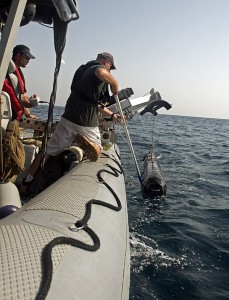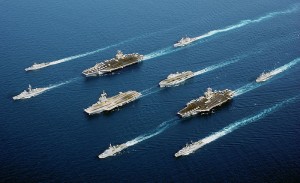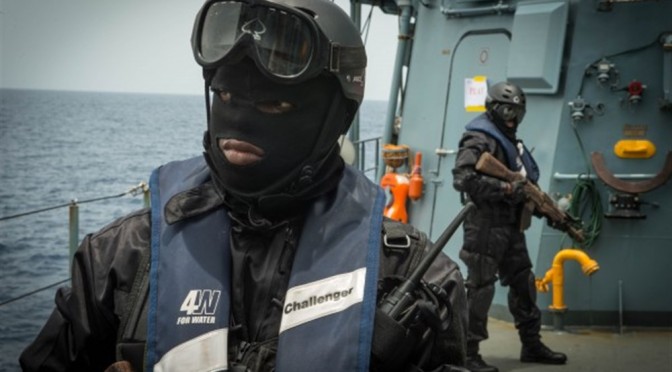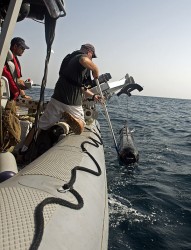 NATO BALTOPS 2015‘s purpose, history, tested capabilities, and future from its NATO leadership – VADM James Foggo (USN), RADM Tim Lowe (RN), and RDML Juan Garat (Spain).
NATO BALTOPS 2015‘s purpose, history, tested capabilities, and future from its NATO leadership – VADM James Foggo (USN), RADM Tim Lowe (RN), and RDML Juan Garat (Spain).
Tag Archives: Fleet Formations
Sea Control 72 – Obangame Express, Gulf of Guinea
 We interview CAPT Rinko, USN, and CDR Sune, Cameroon, about Obangame Express, the 23 Nation Gulf of Guinea Maritime Security exercise. We discuss the scope and purpose of the exercise, the challenges of building cross-organizational/ cultural/ national inter-operability, and lessons learned. For context on the ongoing expansion and conduct of Obangame Express, CIMSEC Africa expert, Dirk Steffen assessed this exercise last year.
We interview CAPT Rinko, USN, and CDR Sune, Cameroon, about Obangame Express, the 23 Nation Gulf of Guinea Maritime Security exercise. We discuss the scope and purpose of the exercise, the challenges of building cross-organizational/ cultural/ national inter-operability, and lessons learned. For context on the ongoing expansion and conduct of Obangame Express, CIMSEC Africa expert, Dirk Steffen assessed this exercise last year.
DOWNLOAD: Sea Control 72:
Obangame Express 2015
Remember, subscribe on iTunes or Stitcher Stream Radio. Leave a comment and rate five stars!
Host and Editing: Matthew Hipple
Music: Sam LaGrone
What You Can’t Find…

A frequently cited fact in my days training to be a naval officer was that the most common weapon for damaging a warship since World War II was the naval mine. The recently concluded International Mine Countermeasures Exercise 2012 (IMCMEX 12), held in 3 distinct OPAREAs throughout the U.S. Fifth Fleet Area of Responsibility (AOR), demonstrated both the difficulty of mine countermeasures (MCM) operations (detecting and clearing mines) and the potential of new technology to mitigate those dangers.
PBS’ News Hour quotes a retired naval officer and observer of the exercise, Capt. Robert O’Donnell, stating of the 29 simulated mines in the exercise, “I don’t think a great many were found…It was probably around half or less.”
The response from the Navy is a little confusing:
The Navy declined to provide data on how many practice mines were located during the two-week naval drill but did not dispute that less than half were found. However, a spokesman insisted that the figures do not tell the whole story and that the event was “‘not just about finding” the dummy mines.
“We enjoyed great success,” said Cdr. Jason Salata, the top public affairs officer for the 5th Fleet. “Every platform that was sent to find a shape found a shape. We stand by that.” Salata asserted that “there were no missed mines, each platform that had an opportunity to find the mine did so.”
While it is true that a 100% detection rate is not what the exercise was all about, that rate is still an interesting figure. It could indicate that every mine was found, but perhaps not by every platform – instead as a result of the cumulative MCM effort. It’s likewise unknown how the success rate broke down by platform and nation – more than 27 international partners operated with U.S. Fifth Fleet as part of the exercise. What is known is that MCM remains a difficult and deadly business, particularly in the context of some of the most likely future conflict scenarios, including Iran and North Korea.
While the exercise results will disappoint some (again, we don’t know who or what had difficulty finding what types of mines), they will also serve to reinforce the arguments for recapitalizing the Avenger-class MCMs, outfitting the USS Ponce as an Afloat Forward Staging Base, and placing rigorous demands on getting the LCS MCM mission package right. As mentioned above, the exercise was additionally an opportunity to test out some new kit. Before the exercise got underway, NavalDrones provided a preview of some of the Remotely Operated Vehicles (ROVs) and Autonomous Underwater Vehicles (AUVs) slated for testing in the drill, as well as a recap of other drones designed for MCM duties. Furthermore, a pair of similar threats might spark the development of crossover technology for use in MCM.
In addition to the more traditional types of naval mines, detecting and defeating the waterborne IEDs and enemy drones (AUVs and ROVs) of both state and non-state actors is seen by some as increasing in importance, and may rely on many of the same technologies used in MCM. Like the land-based IED/counter-IED arms-race of the past decade, we could be witnessing the start of a similar set of opposing innovation escalations. Foreign Policy earlier this week reported that the creation of the Iraq/Afghanistan wars, the Joint IED Defeat Organization (JIEDDO), is executing its own Pivot to the Pacific to focus on the typically lower-tech threats of waterborne terrorists and IEDs. Meanwhile NavalDrones last week highlighted some of the detection and clearance technologies that could be used against the evolving undersea drone fleets. The next decade is shaping up to be an interesting time for technology under the waves.
What Would Sir Julian Corbett Write…
 …today, about the constitution of modern fleets? When Corbett spoke about battleships, cruisers and the flotilla, he focused on the integrated fleet functions these ships performed more than their individual capabilities. Even their names reflected this attitude, contrary to later ship types like the aircraft carrier, submarine or torpedo boat. Corbett was aware that such classification was not constant and that technology was rearranging the old structure of fleets:
…today, about the constitution of modern fleets? When Corbett spoke about battleships, cruisers and the flotilla, he focused on the integrated fleet functions these ships performed more than their individual capabilities. Even their names reflected this attitude, contrary to later ship types like the aircraft carrier, submarine or torpedo boat. Corbett was aware that such classification was not constant and that technology was rearranging the old structure of fleets:We retain the three-fold nomenclature, but the system itself has really gone. Battleships grade into armoured cruisers, armoured cruisers into protected cruisers. We can scarcely detect any real distinction except a twofold one between vessels whose primary armament is the gun and vessels whose primary armament is the torpedo. But even here the existence of a type of cruiser designed to act with flotillas blurs the outline, while, as we have seen, the larger units of the flotilla are grading up to cruiser level.”
Corbett believed that the constitution of fleets ought to reflect the dominant strategic and tactical ideas at a given time. With these thoughts in mind, what kind of prevailing strategic and tactical ideas are expressed by structureless fleet? Do modern navies posses a clear structure? If not, either his theories are obsolete or our concept of ships and fleets is dangerously detached from strategy.
Confusion over fleet constitution, in any time, seems to be caused by three reasons. One is technology, and the addition of new capabilities. Another is perhaps best expressed in the wisdom of Thucydides regarding the reasons for conducting a war – Fear, Honor and Benefit. Fear is rooted deeply in psychology and affects the perceived level of threat. The final reason is inability to predict the future, despite all scientific progress in forecasting. Attempting to follow Corbett’s logic, a navy performs the basic functions of striking, scouting and screening in three dimensions – surface, air and below surface. The three sources of confusion, on the other hand, cause navies to give a ship capabilities in all functional areas and in all domains at the same time. We want to give our scouting force fighting power, forgetting a bit about another statement from Corbett:
The object of naval warfare is to control maritime communications. In order to exercise that control effectively we must have a numerous class of vessels specially adapted for pursuit. But their power of exercising control is in proportion to our degree of command, that is, to our power of preventing their operations being interfered with by the enemy. Their own power of resistance is in inverse proportion to their power of exercising control; that is to say, the more numerous and better adapted they are for preying on commerce and transports, the weaker will be their individual fighting power.”
At this point LCS comes to my mind. Still controversial and presenting challenges to implementation, this project possesses a unique capability. Through modularity and autonomous, off-board systems, it offers a possibility to correct errors in its initial operating concept. Controversy surrounding this ship would be best resolved by return to the roots of the concept and intended function. Answering the question “what is this ship?” is far more important than its actual capabilities. The story of HMS Jervis Bay dramatically illustrates the difference between concept and capability. In May 1940, this armed merchant ship was performing its function of escorting a convoy, consisting of 37 ships, when they encountered German pocket battleship Admiral Scheer. The price for the British was high as almost 200 men died and the ship lost, but the HMS Jervis Bay fulfilled its mission despite having almost no capabilities, charging the Admiral Scheer and enabling the convoy to escape. One way to avoid paying such a price is to give every ship enough fighting power (with all the attendant controversy over exactly how much is enough). Another is to give fleet a more defined structure:
On cruisers depends our exercise of control; on the battle-fleet depends the security of control.”
Closing the loop and returning to the opening question. The chapter title in which Sir Julian Corbett expressed his views on fleet structure is “THEORY OF THE MEANS—THE CONSTITUTION OF FLEETS.” The subject so defined will never be obsolete. I am still curious how he would today find a way through the jungle of new technological innovations which seem to force us to constantly revise operating concepts, and bring us a clear view on the theory of the means.
Przemek Krajewski alias Viribus Unitis is a blogger In Poland. His area of interest is broad context of purpose and structure of Navy and promoting discussions on these subjects In his country




